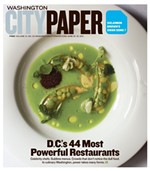Code Unknown
For most American filmgoers, there’s a frustrating but brief period between attending PG pictures with the ’rents and walking into NC-17 flicks unchallenged. After those awkward years, the Motion Picture Association of America rating system becomes irrelevant. Unless, of course, you’re a movie director with an interest in risky—which mostly means sexual—material. The sort of director who might, say, make a documentary titled Sick: The Life & Death of Bob Flanagan, Supermasochist.
That hard-to-watch but hardly sensationalized 1997 movie is the work of Kirby Dick, who has understandable sympathy for low-budget filmmakers who’ve tangled with the MPAA’s secretive ratings board. And so he made This Film Is Not Yet Rated, an analysis and an exposé of the classification system that largely botches both assignments. There’s interesting stuff in Dick’s film, but its overall impact is weak. If the MPAA is Goliath, this documentary is David with a lousy sense of aim.
The director proceeds on two parallel tracks. He marshals disgruntled directors, actors, critics, and other observers (including two former raters) to discuss their personal experiences and general complaints against the association. Meanwhile, he and the L.A. private detective he’s hired try to penetrate the ratings board, scavenging garbage and staking out the association’s Encino headquarters in hopes of identifying the raters, whose names the MPAA does not reveal.
Playing defense are a few MPAA officials, notably longtime director Jack Valenti, who retired in 2004 after 38 years of running the organization. The ratings code, which debuted in 1968, is generally considered Valenti’s baby, and he continues to extol it. There have been many minor changes over the years: M became GP, then PG, and finally was divided into PG and PG-13. X became a generic term and was replaced by NC-17. Recently, more detailed advisories were added to supplement the ratings. Yet the basics are unchanged: The ratings are still justified primarily as a service to parents, and only MPAA members—the major studios and their “indie” subsidiaries—are required to submit their films for ratings.
The ratings system’s influence over filmmakers is indirect, and the major issue is the NC-17 tag. Directors are often contractually obligated to deliver a certain rating, which usually rules out NC-17 films, since many exhibitors, advertising outlets, and video retailers won’t touch them. Such ratings-whipped directors as Matt (Team America) Stone, Kevin (Clerks II) Smith, John (A Dirty Shame) Waters, and Atom (Where the Truth Lies) Egoyan argue that the MPAA’s raters go easy on violence but are disturbed by gay sexuality and “female pleasure.” This may seem like received wisdom from a gender-studies class, but anyone who’s seen a lot of the relatively few films the MPAA has rated NC-17 knows it’s true; women who come and then don’t die are a threat, and lesbian lovemaking almost guarantees the most restrictive rating. The directors offer specific examples: Kimberly (Boys Don’t Cry) Peirce was told that “Lana’s orgasm was too long,” and Mary (American Psycho) Harron realized that the raters were more upset by her movie’s three-way than by its gruesome murders. Actress Maria Bello also appears, talking about the raters’ discussion of her pubic hair in The Cooler.
In between these talking-head interviews, Dick and a lesbian PI finger nearly all the current members of the MPAA ratings board. This part of the film is supposed to be its motor, supplying “narrative” to propel the analytical portion. Instead, it’s a distraction, like the seemingly endless search for Los Angeles’ last plug-in sedans in Who Killed the Electric Car? The investigators discover some provocative things, notably that many of the raters do not meet the MPAA’s own guidelines. (Some of them, for example, lack the requisite school-age kids.) But the documentary would have been sleeker if it had presented this information straight up, without the meandering sequences that show how it was attained. And things only get shaggier when Dick submits this film to get the expected NC-17 rating, so he can experience the shadowy appeal process. The director uses animation, drawings, and voice-over to depict the off-the-record proceedings, making the whole experience seem a self-indulgent goof.
This trip might have been necessary if the MPAA ratings were as nefarious as their opponents suggest. After all, at various times in This Film Is Not Yet Rated, the system is termed “fascist,” “unconstitutional,” and a mechanism that increases the mass media conglomerates’ control of popular culture. But Dick merely assumes these accusations are true and never really makes the case for them.
In fact, the current American movie distribution and exhibition system discriminates against all small-budget films, and it’s probably harder on those with foreign-language dialogue than those with pubic hair. And though the Showgirls experience soured Hollywood studios on NC-17 flicks, it also demonstrated that movies with that rating can reach a mass audience if given the same sort of multi-million-dollar push that routinely boosts PG-13 blockbusters. Yes, the NC-17 rating will keep films out of certain chains, but those chains don’t usually book offbeat stuff anyway. Increasingly, the art- and indie-film market is a home-video one, dominated by Netflix, which handles NC-17 and unrated movies. Sick is available there, and This Film Is Not Yet Rated probably will be soon. Both are unrated and as accessible to adult viewers as any other recent indie release. The MPAA system may not function reasonably, but sidestepping it seems to be easy enough.

